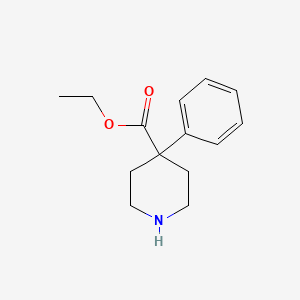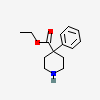Normeperidine
- Ethyl 4-phenylpiperidine-4-carboxylate
- Normeperidine
- Norpethidine
- 77-17-8
- Nordolsin
- Create:2005-03-26
- Modify:2025-01-18

- normeperidine
- normeperidine carbonate (2:1)
- normeperidine hydrochloride
- normeperidine, 3H-labeled cpd
- norpethidine
- Ethyl 4-phenylpiperidine-4-carboxylate
- Normeperidine
- Norpethidine
- 77-17-8
- Nordolsin
- 4-Carbethoxy-4-phenylpiperidine
- Ethyl 4-phenylisonipecotate
- 4-Phenyl-4-carbethoxypiperidine
- 4-(Ethoxycarbonyl)-4-phenylpiperidine
- 4-Phenylpiperidine-4-carboxylic acid ethyl ester
- Isonipecotic acid, 4-phenyl-, ethyl ester
- UNII-JG096PMW2N
- 4-Piperidinecarboxylic acid, 4-phenyl-, ethyl ester
- JG096PMW2N
- PETHIDINE INTERMEDIATE B
- EINECS 201-008-9
- N-DESMETHYLMEPERIDINE
- CHEMBL1052
- IDS-NP-003
- DTXSID50227806
- NSC-23821
- Ethyl 4-phenyl-4-piperidinecarboxylate
- Ethyl-4-phenylpiperidine-4-carboxylate
- 4-Phenyl-piperidine-4-carboxylic acid ethyl ester
- PETHIDINE-INTERMEDIATE-B, ETHYL-4-PHENYLPIPERIDINE-4-CARBOXYLATE
- Pethidine - Intermediate-B
- Norpethidine (Normeperidine)
- SCHEMBL341796
- DEA No. 9233
- DTXCID60150297
- 4-phenyl-4-carboethoxy-piperidine
- 4-ethoxycarbonyl-4-phenylpiperidine
- BDBM50071692
- STK689062
- AKOS005601310
- NCGC00160433-01
- AS-37791
- Ethyl 4-phenyl-4-piperidinecarboxylate #
- 1ST10260-1000M
- DB-075255
- NS00010413
- C22685
- Norpethidine (Normeperidine) 0.1 mg/ml in Methanol
- Q7053200
- W-104326
- Isonipecotic acid, 4-phenyl-, ethyl ester (6CI,7CI,8CI)

P264, P270, P301+P317, P330, and P501
(The corresponding statement to each P-code can be found at the GHS Classification page.)
Aggregated GHS information provided per 39 reports by companies from 2 notifications to the ECHA C&L Inventory.
Information may vary between notifications depending on impurities, additives, and other factors. The percentage value in parenthesis indicates the notified classification ratio from companies that provide hazard codes. Only hazard codes with percentage values above 10% are shown.
IMAP assessments - 4-Piperidinecarboxylic acid, 4-phenyl-, ethyl ester: Environment tier I assessment
IMAP assessments - 4-Piperidinecarboxylic acid, 4-phenyl-, ethyl ester: Human health tier I assessment
Patents are available for this chemical structure:
https://patentscope.wipo.int/search/en/result.jsf?inchikey=QKHMFBKXTNQCTM-UHFFFAOYSA-N
- Australian Industrial Chemicals Introduction Scheme (AICIS)4-Piperidinecarboxylic acid, 4-phenyl-, ethyl esterhttps://services.industrialchemicals.gov.au/search-assessments/
- CAS Common ChemistryLICENSEThe data from CAS Common Chemistry is provided under a CC-BY-NC 4.0 license, unless otherwise stated.https://creativecommons.org/licenses/by-nc/4.0/
- ChemIDplusChemIDplus Chemical Information Classificationhttps://pubchem.ncbi.nlm.nih.gov/source/ChemIDplus
- EPA DSSToxNormeperidinehttps://comptox.epa.gov/dashboard/DTXSID50227806CompTox Chemicals Dashboard Chemical Listshttps://comptox.epa.gov/dashboard/chemical-lists/
- European Chemicals Agency (ECHA)LICENSEUse of the information, documents and data from the ECHA website is subject to the terms and conditions of this Legal Notice, and subject to other binding limitations provided for under applicable law, the information, documents and data made available on the ECHA website may be reproduced, distributed and/or used, totally or in part, for non-commercial purposes provided that ECHA is acknowledged as the source: "Source: European Chemicals Agency, http://echa.europa.eu/". Such acknowledgement must be included in each copy of the material. ECHA permits and encourages organisations and individuals to create links to the ECHA website under the following cumulative conditions: Links can only be made to webpages that provide a link to the Legal Notice page.https://echa.europa.eu/web/guest/legal-noticeEthyl 4-phenylpiperidine-4-carboxylatehttps://echa.europa.eu/substance-information/-/substanceinfo/100.000.918Ethyl 4-phenylpiperidine-4-carboxylate (EC: 201-008-9)https://echa.europa.eu/information-on-chemicals/cl-inventory-database/-/discli/details/1348
- FDA Global Substance Registration System (GSRS)LICENSEUnless otherwise noted, the contents of the FDA website (www.fda.gov), both text and graphics, are not copyrighted. They are in the public domain and may be republished, reprinted and otherwise used freely by anyone without the need to obtain permission from FDA. Credit to the U.S. Food and Drug Administration as the source is appreciated but not required.https://www.fda.gov/about-fda/about-website/website-policies#linking
- Human Metabolome Database (HMDB)LICENSEHMDB is offered to the public as a freely available resource. Use and re-distribution of the data, in whole or in part, for commercial purposes requires explicit permission of the authors and explicit acknowledgment of the source material (HMDB) and the original publication (see the HMDB citing page). We ask that users who download significant portions of the database cite the HMDB paper in any resulting publications.http://www.hmdb.ca/citingNormeperidinehttp://www.hmdb.ca/metabolites/HMDB0041958
- ChEMBLLICENSEAccess to the web interface of ChEMBL is made under the EBI's Terms of Use (http://www.ebi.ac.uk/Information/termsofuse.html). The ChEMBL data is made available on a Creative Commons Attribution-Share Alike 3.0 Unported License (http://creativecommons.org/licenses/by-sa/3.0/).http://www.ebi.ac.uk/Information/termsofuse.htmlChEMBL Protein Target Treehttps://www.ebi.ac.uk/chembl/g/#browse/targets
- Comparative Toxicogenomics Database (CTD)LICENSEIt is to be used only for research and educational purposes. Any reproduction or use for commercial purpose is prohibited without the prior express written permission of NC State University.http://ctdbase.org/about/legal.jspnormeperidinehttps://ctdbase.org/detail.go?type=chem&acc=C002752
- Drug Enforcement Administration (DEA)LICENSEUnless otherwise indicated, information on Department of Justice websites is in the public domain and may be copied and distributed without permission. Citation of the Department of Justice as source of the information is appreciated, as appropriate.https://www.justice.gov/legalpoliciesPethidine-Intermediate-B, ethyl-4-phenylpiperidine-4-carboxylatehttps://www.deadiversion.usdoj.gov/schedules/DEA drug and chemical classificationhttps://www.dea.gov/drug-information/drug-scheduling
- Drug Gene Interaction database (DGIdb)LICENSEThe data used in DGIdb is all open access and where possible made available as raw data dumps in the downloads section.http://www.dgidb.org/downloadsNORMEPERIDINEhttps://www.dgidb.org/drugs/chembl:CHEMBL1052
- Japan Chemical Substance Dictionary (Nikkaji)
- KEGGLICENSEAcademic users may freely use the KEGG website. Non-academic use of KEGG generally requires a commercial licensehttps://www.kegg.jp/kegg/legal.html
- Metabolomics Workbench
- NIST Mass Spectrometry Data CenterLICENSEData covered by the Standard Reference Data Act of 1968 as amended.https://www.nist.gov/srd/public-law4-Piperidinecarboxylic acid, 4-phenyl-, ethyl esterhttp://www.nist.gov/srd/nist1a.cfm
- SpectraBaseNormeperidinehttps://spectrabase.com/spectrum/Y0y8Q1y68eNormeperidinehttps://spectrabase.com/spectrum/5ZC0f1jlwM4
- NORMAN Suspect List ExchangeLICENSEData: CC-BY 4.0; Code (hosted by ECI, LCSB): Artistic-2.0https://creativecommons.org/licenses/by/4.0/normeperidineNORMAN Suspect List Exchange Classificationhttps://www.norman-network.com/nds/SLE/
- PharmGKBLICENSEPharmGKB data are subject to the Creative Commons Attribution-ShareALike 4.0 license (https://creativecommons.org/licenses/by-sa/4.0/).https://www.pharmgkb.org/page/policiesnormeperidinehttps://www.pharmgkb.org/chemical/PA166186301
- Springer Nature
- Thieme ChemistryLICENSEThe Thieme Chemistry contribution within PubChem is provided under a CC-BY-NC-ND 4.0 license, unless otherwise stated.https://creativecommons.org/licenses/by-nc-nd/4.0/
- Wikidatanormeperidinehttps://www.wikidata.org/wiki/Q7053200
- Wikipedia4-Chloroanilinehttps://en.wikipedia.org/wiki/4-ChloroanilineNorpethidinehttps://en.wikipedia.org/wiki/Norpethidine
- PubChem
- Medical Subject Headings (MeSH)LICENSEWorks produced by the U.S. government are not subject to copyright protection in the United States. Any such works found on National Library of Medicine (NLM) Web sites may be freely used or reproduced without permission in the U.S.https://www.nlm.nih.gov/copyright.htmlnormeperidinehttps://www.ncbi.nlm.nih.gov/mesh/67002752Cholinesterase Inhibitorshttps://www.ncbi.nlm.nih.gov/mesh/68002800
- GHS Classification (UNECE)GHS Classification Treehttp://www.unece.org/trans/danger/publi/ghs/ghs_welcome_e.html
- MolGenieMolGenie Organic Chemistry Ontologyhttps://github.com/MolGenie/ontology/
- PATENTSCOPE (WIPO)SID 403456706https://pubchem.ncbi.nlm.nih.gov/substance/403456706
- NCBI

